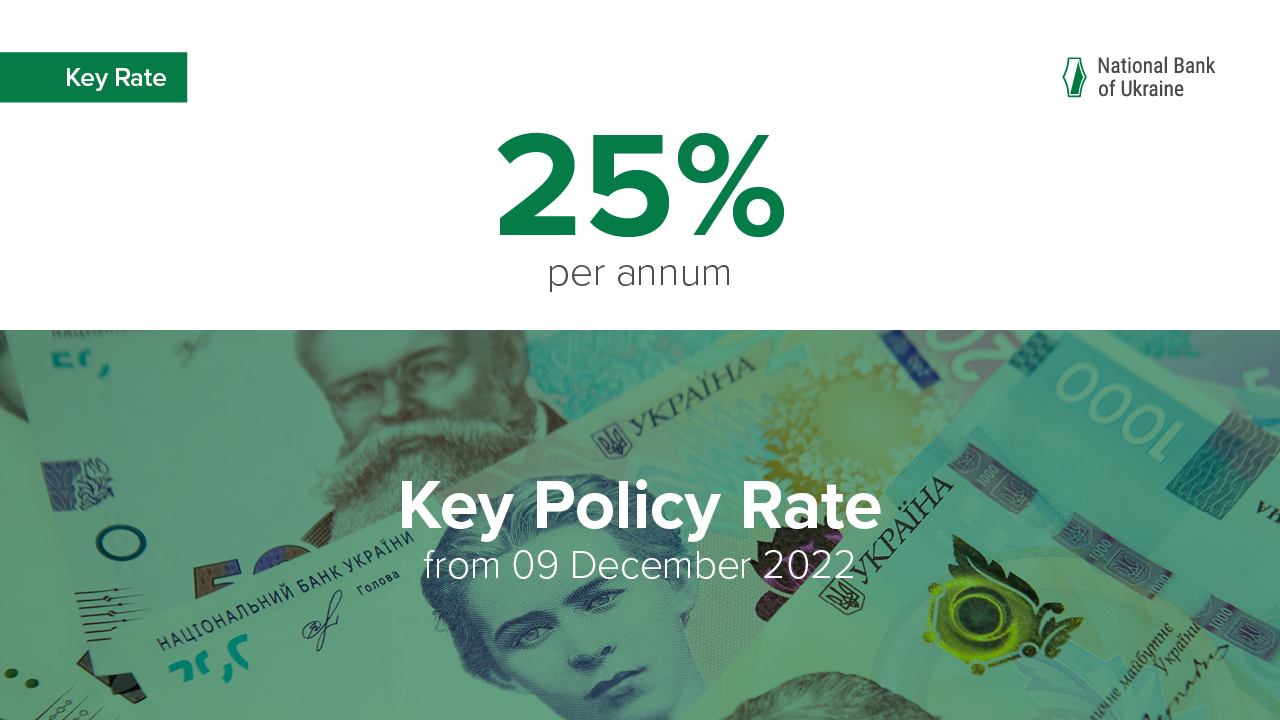The Board of the National Bank of Ukraine has decided to keep its key policy rate at 25% per annum and to raise reserve requirements for banks. This will enhance monetary transmission, support exchange rate stability, and gradually slow inflation in 2023.
Inflation continues to grow, but the growth is somewhat slower than forecast by the NBU
The rise in consumer prices in Ukraine accelerated to 26.6% yoy as of end-October. According to the NBU’s preliminary estimates, inflation continued to increase in November, albeit slower than envisaged in the October forecast (October 2022 Inflation Report).
The rise in inflation continues to be driven mainly by consequences of hostilities and occupation of some regions of Ukraine, which primarily pushes up production costs and causes shortages of some products. A surge of russia’s terrorist attacks against Ukraine’s critical infrastructure, particularly targeting power supply facilities, is affecting economic activity in various sectors – from metals industry to food industry, animal farming, and the services sector. In particular, businesses’ expenses on maintaining uninterrupted operations amid regular power outages have grown considerably over past several months. In addition, the shortage of electric power causes production cuts, leading to a decrease in supply of goods. Households’ higher demand for fuel on the back of regular power outages creates additional pressure on energy prices. All the above factors are driving an increase in prices for a wide range of goods and services, with prices for some items surging.
Nevertheless, the overall dynamics of inflation remain under control and are even slightly below the trajectory of the macroeconomic forecast the NBU made in October. The gradual tightening of monetary conditions following the key policy rate hike to 25% in June and fixing the official hryvnia exchange rate are playing a major role in stabilizing inflation expectations. Thanks to FX market regulation and the introduction of new savings protection instruments, the spread between the hryvnia exchange rate on the cash market and the official exchange rate narrowed markedly. Coupled with strict adherence by the NBU and the government to their joint plan to reduce monetary financing of the budget deficit, this eased pressures on the FX market and resulted in a decrease in net FX sales by the NBU. In addition, large inflows of financial assistance drove an increase in international reserves, strengthening the NBU’s capability to maintain exchange rate stability. Unchanged utility tariffs also remain important for restraining inflation. Moreover, in November, increased supply put the brakes on the growth in prices for some food products that had been growing rapidly in previous months.
The cycle of annual inflation deceleration is expected to start in Q2 2023
After this year’s inflation surge caused by the full-scale war, the growth in consumer prices will slow as of the end of next year. This should be primarily driven by security risks subsiding thanks to the success of the Armed Forces of Ukraine. Liberation of occupied territories, setting up production and logistics, and increased capability of maritime logistics will play an important role in curbing inflation processes.
Well-coordinated fiscal and monetary policies will remain essential for steady disinflation next year. In particular, monetary financing of the budget is expected to cease from the start of 2023. The optimization of budget expenditures, international support, and a recovery in domestic debt market will enable the government to secure planned revenues and finance all critical expenditures. At the same time, the NBU keeping monetary conditions relatively tight will help increase the attractiveness of hryvnia assets and prevent the development of an inflation and depreciation spiral. This year’s low base and a gradual decline in global energy prices will also contribute to slower inflation.
However, as before, the NBU does not expect rapid disinflation during the war. The Ukrainian economy will continue facing limited logistics and electricity shortages in the long run. Weaker consumer demand can only partially offset the inflationary effect from higher production costs. Therefore, inflation will decelerate slowly and will significantly exceed the NBU’s 5% target in 2023–2024. Under such conditions, the NBU will focus on maintaining control of inflation expectations and reining in inflation processes.
Sufficient and regular inflows of international financing and cooperation with the IMF remain an important precondition for the stable functioning of the economy in wartime
In H2 2022, international partners considerably increased their financial assistance to Ukraine, which played an important role in maintaining macrofinancial stability. International assistance is expected to exceed USD 31 billion as of the end of this year.
International financial assistance needed to finance the budget deficit and restore the economy will continue to arrive into 2023. More specifically, the European Union and the Unites States have already announced their preliminary intentions to provide Ukraine with EUR 18 billion and about USD 10 billion respectively. As in 2022, a considerable portion of these funds is expected to be given as grants, which will not push up Ukraine’s debt burden in the post-war period.
What is more, Ukraine has made some progress in negotiating with the IMF a new monitoring program involving the IMF Executive Board. Once finalized, this program will help Ukraine obtain financing from other international donors in 2023. The NBU expects that an Extended Fund Facility will be approved for Ukraine after the monitoring program expires.
Ukraine is also negotiating over obtaining financing from other partner countries and international financial organizations.
An extended full-scale war by russia and escalating terrorist attacks on the country’s critical infrastructure are the key risks for Ukraine’s economic development
Risks for the economy remain elevated.
On the one hand, the threat that the "grain corridor" will cease operating and risks that Ukraine will not obtain enough external financing have declined. The reduction in the risks resulted, among other things, from Ukraine’s international partners reiterating their commitments, and from successful talks with the IMF. The smaller extent of the NBU’s interventions to sell FX and larger international reserves than expected in October have decreased risks to exchange rate stability and control over price growth.
On the other hand, russia has scaled up its terrorist attacks on Ukraine’s energy infrastructure. The risk of continued terrorist attacks on Ukraine’s critical infrastructure persists. The NBU’s October macroeconomic forecast contained assumptions that power transmitting and generating facilities will be temporarily unavailable in winter. However, the scale and duration of blackouts could be greater than expected. This could dampen economic activity and increase inflationary pressures.
Other risks also remain relevant. If realized, these risks will worsen inflation dynamics and hold back economic recovery. More specifically:
- despite a certain easing, the risk of state finances becoming unbalanced persists on the back of the unpredictable nature of the war and the emergence of additional budgetary needs. Taking into account high energy prices, a separate problem could arise from the formation of large quasi-fiscal deficits in the energy sector.
- the duration and intensity of hostilities, together with energy terror attacks, are increasing the risk that a large part of the Ukrainians who have gone abroad will not return, and that some more Ukrainians may decide to leave Ukraine, at least during the heating season. In the short term, this will depress consumer demand, while in the longer term, it threatens to create a demographic crisis and to aggravate structural problems on the labor market.
In view of the expected price movements, persistently high inflation expectations and the upward shift of the balance of risks, the NBU Board decided to keep the key policy rate at 25%, while also tightening reserve requirements for banks in order to strengthen monetary transmission
The banking system’s liquidity surplus hit a record high in late 2022, slowing the monetary transmission from the June hike in the key policy rate. In particular, the rise in interest rates on hryvnia deposits did not meet expectations, considering an enduring large spread between the cost of the banks’ liabilities and their return on assets.
Given heightened inflation and exchange rate expectations, the lack of attractive instruments for household hryvnia deposits is making the financial system more sensitive to situational factors. This is posing risks to macrofinancial stability, requiring the NBU to take additional steps to sterilize the surfeit of the supply of hryvnias. In view of the above, the NBU has increased the required reserve ratios for hryvnia and FX current accounts by 5 pp.
At the same time, the NBU will allow the banks to use benchmark domestic government debt securities to meet up to 50% of their total required reserve ratios. The NBU will decide separately on a list of securities eligible for meeting the required reserve ratios, on the basis of proposals made by the Finance Ministry.
The banks must start complying with new reserve requirements from 11 January 2023, using domestic government debt securities to meet a portion of their required reserve ratios if they chose to do so.
This mechanism will encourage the banks to expand their portfolios of domestic government bonds, lowering the risk of returning to the monetary financing of the budget deficit in 2023.
After assessing the effectiveness of the above measures and changes in the banking system’s liquidity, the NBU will decide whether or not it should increase the required reserve ratios any further.
If pro-inflationary risks materialize, the NBU stands ready to tighten monetary conditions in order to keep the exchange rate and inflation in check
Among other things, the NBU will evaluate the results of the measures taken and their impact on the FX and domestic debt market. The central bank will also consider the prospects of Ukraine’s receiving sufficient amounts of international financial aid in good time, price and inflation expectations dynamics, and produce a revised macroeconomic forecast, which will be presented in late January 2023.
The decision to keep the key policy rate at 25% per annum was approved by an NBU Board Decision on the key policy rate No. 576, dated 8 December 2022.
A summary of the discussion between the members of the Monetary Policy Committee that preceded the approval of this decision will be published on 19 December 2022.
The next meeting of the NBU Board on monetary policy issues will be held on 26 January 2023, according to the confirmed and published schedule.


